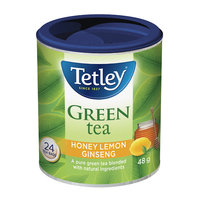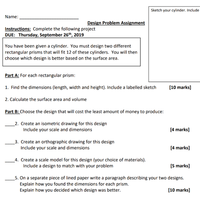You are using an out of date browser. It may not display this or other websites correctly.
You should upgrade or use an alternative browser.
You should upgrade or use an alternative browser.
Geometry Isometric Design Problem
- Thread starter Zenos
- Start date
Dr.Peterson
Elite Member
- Joined
- Nov 12, 2017
- Messages
- 16,869
I would start by imagining a couple different ways the cans could be arranged in a box -- for example, one layer 3 by 4, or two layers 2 by 3.
Then think about what the dimensions of each box would be, and do the calculations you were asked for.
Then think about what the dimensions of each box would be, and do the calculations you were asked for.
HallsofIvy
Elite Member
- Joined
- Jan 27, 2012
- Messages
- 7,760
I don't see anywhere where the height and diameter of the can is given! Am I missing something?
Without that, I would call the height of a single can "h" and the diameter "d" and calculate everything sin terms of h and d. Each can will sit in a rectangle with dimensions "h by d by d". Any box contain 12 cans will have volume $12hd^2$ but the surface area will depend upon how the cans are positioned.
Following Dr. Peterson's suggestion, if the cans are set "3 by 4" then the length of the box will be 4d, the width 3d, and the height h. Such a box will have a top and bottom "4d by 3d". What is the area of such a rectangle? Two of the sides will be "4d by h" and the other two will be "3d by h". What will be the total area? (Don't forget that there are 2 of everything!)
If, instead, the cans are set in tw layers, each "2 by 3" you will have a rectangle with top and bottom of "2d by 3d", two sides of "2d by 2h", and two sides "3d by 2h".
Without that, I would call the height of a single can "h" and the diameter "d" and calculate everything sin terms of h and d. Each can will sit in a rectangle with dimensions "h by d by d". Any box contain 12 cans will have volume $12hd^2$ but the surface area will depend upon how the cans are positioned.
Following Dr. Peterson's suggestion, if the cans are set "3 by 4" then the length of the box will be 4d, the width 3d, and the height h. Such a box will have a top and bottom "4d by 3d". What is the area of such a rectangle? Two of the sides will be "4d by h" and the other two will be "3d by h". What will be the total area? (Don't forget that there are 2 of everything!)
If, instead, the cans are set in tw layers, each "2 by 3" you will have a rectangle with top and bottom of "2d by 3d", two sides of "2d by 2h", and two sides "3d by 2h".
Dr.Peterson
Elite Member
- Joined
- Nov 12, 2017
- Messages
- 16,869
I'm guessing, since the problem said, "You have been given a cylinder," that you are expected to measure an actual physical can you have been given; otherwise, perhaps you can measure the picture, or search for information about that particular can size ...
D
Deleted member 4993
Guest
Are you allowed to ask for external help?I can not ask my teacher for help since he said that he will take marks away if he helps me.
Many teachers visit this web-site.......
He said that I cannot ask him for help but can get help from other people.Are you allowed to ask for external help?
Many teachers visit this web-site.......
Sorry, the dimensions for the can are 8.5cm for height, 7cm for diameter and 21.98cm circumference and 7 cm for width.I don't see anywhere where the height and diameter of the can is given! Am I missing something?
Without that, I would call the height of a single can "h" and the diameter "d" and calculate everything sin terms of h and d. Each can will sit in a rectangle with dimensions "h by d by d". Any box contain 12 cans will have volume $12hd^2$ but the surface area will depend upon how the cans are positioned.
Following Dr. Peterson's suggestion, if the cans are set "3 by 4" then the length of the box will be 4d, the width 3d, and the height h. Such a box will have a top and bottom "4d by 3d". What is the area of such a rectangle? Two of the sides will be "4d by h" and the other two will be "3d by h". What will be the total area? (Don't forget that there are 2 of everything!)
If, instead, the cans are set in tw layers, each "2 by 3" you will have a rectangle with top and bottom of "2d by 3d", two sides of "2d by 2h", and two sides "3d by 2h".
Dr.Peterson
Elite Member
- Joined
- Nov 12, 2017
- Messages
- 16,869
So you have the data you need, and several ideas. Give it a try, and show us what you come up with if you need more help.
Ok, thank you for helping out, I finally got an idea of what to do. Lets just hope I do it goodSo you have the data you need, and several ideas. Give it a try, and show us what you come up with if you need more help.


